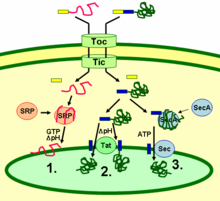
The TIC and TOC complexes are translocons located in the chloroplast of a eukaryotic cell, that is, protein complexes that facilitate the transfer of proteins in and out through the chloroplast's membrane. It mainly transports proteins made in the cytoplasm into the chloroplast. The TIC complex (translocon on the inner chloroplast membrane) is located in the inner envelope of the chloroplast. The TOC complex (translocon on the outer chloroplast membrane) is located in the outer envelope of the chloroplast.
TOM/TIM complex vs. TOC/TIC complex

This protein complex is functionally similar to the TOM/TIM Complex located on the outer and inner membranes of the mitochondria, in the sense that it too transports proteins across multiple membranes and into the lumen of an organelle. Both complexes (TOC/TIC) are GTPases, that is, they must both hydrolyze GTP in order to power the translocation. The chloroplast also harnesses the power of an electrochemical gradient using protons. The gradient is only used to power transport across the thylakoid membrane, however, while the gradient in the mitochondria is used to power transport across its inner membrane.
Furthermore, due to the thylakoid membrane located inside of the chloroplast, a second transit peptide sequence must be located on the imported protein. In the cytosol, a transit peptide that signals for transit of the protein to the chloroplast is exposed. This initiates transport and translocation through the TIC/TOC complexes into the stroma of the chloroplast. It is there that a signal peptidase cleaves the stromal transit peptide, only to reveal a second transit peptide sequence underneath; this time directing to the thylakoid membrane. There are at least three ways for the protein to go through the thylakoid membrane: through a ATP-hydrolyzing Type II secretion system, through a SecY translocon, or through the Tat/VSP pathway.
Protein domain| AIG1-type guanine nucleotide-binding (G) domain | |||||||||
|---|---|---|---|---|---|---|---|---|---|
| Identifiers | |||||||||
| Symbol | G_AIG1 | ||||||||
| Pfam | PF04548 | ||||||||
| InterPro | IPR006703 | ||||||||
| TCDB | 3.A.9 | ||||||||
| Membranome | 176 | ||||||||
| |||||||||
See also
References
- Stengel A, Benz JP, Buchanan BB, Soll J, Bölter B (November 2009). "Preprotein import into chloroplasts via the Toc and Tic complexes is regulated by redox signals in Pisum sativum". Molecular Plant. 2 (6): 1181–97. doi:10.1093/mp/ssp043. PMID 19995724.
- Gutensohn, M; Fan, E; Frielingsdorf, S; Hanner, P; Hou, B; Hust, B; Klösgen, RB (February 2006). "Toc, Tic, Tat et al.: structure and function of protein transport machineries in chloroplasts". Journal of Plant Physiology. 163 (3): 333–47. doi:10.1016/j.jplph.2005.11.009. PMID 16386331.
- Alberts B, Johnson A, Lewis J, Raff M, Roberts K, Walter P. Molecular biology of the cell (4th ed.). Garland Science. ISBN 978-0-8153-3218-3.
- Li HM, Chiu CC (2010). "Protein transport into chloroplasts". Annual Review of Plant Biology. 61: 157–80. doi:10.1146/annurev-arplant-042809-112222. PMID 20192748.
- Rolland, V; Rae, BD; Long, BM (2 November 2017). "Setting sub-organellar sights: accurate targeting of multi-transmembrane-domain proteins to specific chloroplast membranes". Journal of Experimental Botany. 68 (18): 5013–5016. doi:10.1093/jxb/erx351. PMC 5853405. PMID 29106623.